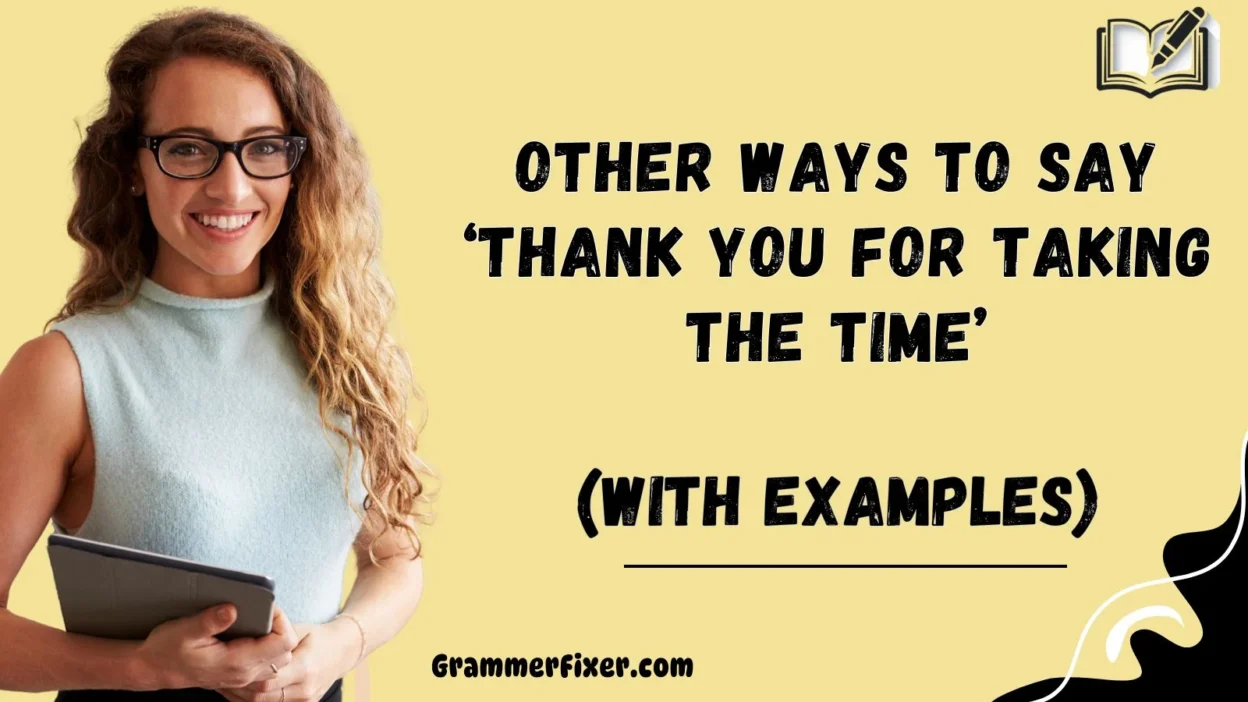Finding the right words to express appreciation can turn a simple message into something memorable and heartfelt. When you say “Thank you for taking the time,” you’re acknowledging effort, presence, and genuine care. But using alternative phrases can make your gratitude sound more personal, meaningful, and suited to different professional or emotional contexts.
Below are 30 professional and thoughtful alternatives, complete with meanings, best uses, and examples to help you express your appreciation sincerely.
What Does “Thank You for Taking the Time” Mean?
The phrase “Thank you for taking the time” is a polite expression of appreciation used to acknowledge someone’s effort, attention, or availability. It recognizes that their time is valuable and that you genuinely appreciate them spending it on you — whether for a meeting, reading an email, or offering feedback.
When to Use “Thank You for Taking the Time”?
Use this phrase in professional, academic, or personal settings when someone invests time in helping, meeting, mentoring, reviewing, or simply responding to you. It’s ideal in emails, interviews, follow-ups, and feedback exchanges, showing you respect their schedule and effort.
Is It Professional/Polite to Say “Thank You for Taking the Time”?
Yes, absolutely. The phrase is polite, professional, and universally accepted in workplace communication. It strikes a balance between warmth and respect, making it ideal for client emails, internal messages, or thank-you notes after meetings or interviews.
Pros or Cons
Pros:
- Universally polite and professional
- Conveys genuine respect for the recipient’s time
- Works across industries and contexts
Cons:
- Can sound slightly generic or overused
- Might lack emotional nuance in personal communication
That’s why exploring alternative ways to express it — as shown below — can help your message feel more authentic, engaging, and thoughtful.
1. I Appreciate You Taking the Time
Meaning: Expresses gratitude while emphasizing the recipient’s personal effort.
Detailed Explanation: Slightly warmer and more personal than the original phrase.
Example: “I truly appreciate you taking the time to review my proposal.”
Best Use: In professional thank-you emails or post-meeting follow-ups.
Worst Use: In highly formal contexts (e.g., corporate reports).
Why It Works: Balances professionalism and sincerity.
Tone: Warm, professional, and appreciative.
2. Thanks for Making the Time
Meaning: Acknowledges that someone adjusted their schedule to help you.
Detailed Explanation: Suggests awareness of their effort to prioritize you.
Example: “Thanks for making the time to discuss the project details today.”
Best Use: When someone rearranges their schedule for you.
Worst Use: In formal writing; sounds conversational.
Why It Works: Feels natural, grateful, and respectful.
Tone: Friendly and conversational.
3. I’m Grateful for Your Time and Attention
Meaning: Highlights appreciation for both time and focus.
Detailed Explanation: Emphasizes thoughtfulness and attentiveness.
Example: “I’m grateful for your time and attention during our discussion.”
Best Use: In emails following client or mentor meetings.
Worst Use: When addressing casual acquaintances.
Why It Works: Shows depth of gratitude and mindfulness.
Tone: Respectful and warm.
4. Thank You for Taking the Time to Connect
Meaning: Appreciates the effort someone made to meet or communicate.
Detailed Explanation: Adds a touch of personal connection.
Example: “Thank you for taking the time to connect with me today.”
Best Use: After networking calls or introductions.
Worst Use: In purely transactional messages.
Why It Works: Feels human and relational.
Tone: Friendly and professional.
5. I Truly Value Your Time
Meaning: Expresses genuine respect for someone’s time.
Detailed Explanation: Makes the gratitude more meaningful by emphasizing value.
Example: “I truly value your time and feedback on this matter.”
Best Use: When someone offers input or mentorship.
Worst Use: In casual chats; sounds formal.
Why It Works: Adds depth and sincerity to your appreciation.
Tone: Respectful and genuine.
6. I Appreciate Your Time and Consideration
Meaning: Thanks someone for both time and thoughtfulness.
Detailed Explanation: Commonly used in professional settings like job applications.
Example: “I appreciate your time and consideration regarding my application.”
Best Use: Formal emails and cover letters.
Worst Use: In personal or casual exchanges.
Why It Works: Professional and polished.
Tone: Formal and courteous.
7. Thank You for Your Kind Attention
Meaning: A refined way to thank someone for listening or reviewing.
Detailed Explanation: Common in business correspondence and polite requests.
Example: “Thank you for your kind attention to this matter.”
Best Use: In emails to clients or management.
Worst Use: In casual internal emails.
Why It Works: Sounds respectful and elegant.
Tone: Formal and diplomatic.
8. Thanks for Your Time and Effort
Meaning: Acknowledges both time and hard work.
Detailed Explanation: Shows deeper appreciation for effort, not just time.
Example: “Thanks for your time and effort in preparing the report.”
Best Use: When someone contributes tangible work.
Worst Use: When the effort was minimal.
Why It Works: Reinforces gratitude for their contribution.
Tone: Appreciative and direct.
9. I Appreciate the Effort You Put In
Meaning: Thanks someone for their contribution and care.
Detailed Explanation: Recognizes initiative and personal dedication.
Example: “I really appreciate the effort you put into refining this proposal.”
Best Use: Team settings or colleague appreciation.
Worst Use: Generic mass emails.
Why It Works: Makes gratitude specific and personal.
Tone: Warm and encouraging.
10. Thank You for Making Yourself Available
Meaning: Acknowledges flexibility and willingness to help.
Detailed Explanation: Highlights availability as a form of generosity.
Example: “Thank you for making yourself available on such short notice.”
Best Use: Meetings or urgent discussions.
Worst Use: Informal chats.
Why It Works: Respectful acknowledgment of effort.
Tone: Professional and polite.
11. I’m Thankful for Your Time
Meaning: A simple and heartfelt alternative.
Detailed Explanation: Strikes a balance between casual and formal.
Example: “I’m thankful for your time and the insights you shared.”
Best Use: After informational interviews or reviews.
Worst Use: In highly formal corporate contexts.
Why It Works: Feels genuine and easy to relate to.
Tone: Kind and sincere.
12. Thanks for Giving This Your Attention
Meaning: Acknowledges focus and care.
Detailed Explanation: Great for written correspondence.
Example: “Thanks for giving this your attention and thoughtful input.”
Best Use: Email follow-ups, project reviews.
Worst Use: Face-to-face casual settings.
Why It Works: Emphasizes attentiveness and engagement.
Tone: Polished and appreciative.
13. I’m Grateful You Took the Time to Respond
Meaning: Appreciates responsiveness and communication.
Detailed Explanation: Recognizes the recipient’s effort in replying.
Example: “I’m grateful you took the time to respond to my inquiry.”
Best Use: After receiving thoughtful feedback.
Worst Use: One-word responses.
Why It Works: Shows gratitude for communication and care.
Tone: Professional and warm.
14. Thank You for Taking the Time to Review This
Meaning: Appreciates feedback or evaluation effort.
Detailed Explanation: Common in workplace and academic writing.
Example: “Thank you for taking the time to review my submission.”
Best Use: Reports, applications, or proposals.
Worst Use: In casual dialogue.
Why It Works: Formal, specific, and respectful.
Tone: Courteous and professional.
15. I Value the Time You Invested
Meaning: Frames time as an investment, showing deep respect.
Detailed Explanation: Suggests appreciation for meaningful commitment.
Example: “I value the time you invested in guiding this project.”
Best Use: Mentorship or long-term projects.
Worst Use: Short interactions.
Why It Works: Elevates the level of gratitude.
Tone: Respectful and heartfelt.
16. Thank You for Setting Aside the Time
Meaning: Recognizes deliberate effort to prioritize you or your matter.
Detailed Explanation: Ideal when someone scheduled you in despite being busy.
Example: “Thank you for setting aside the time to meet with me yesterday.”
Best Use: Meetings, interviews, or feedback sessions.
Worst Use: Routine interactions.
Why It Works: Shows you value their intentional effort.
Tone: Courteous and respectful.
17. I Appreciate You Making Time for Me
Meaning: Expresses personal gratitude for someone’s attention or help.
Detailed Explanation: Slightly more emotional and personal than the standard version.
Example: “I really appreciate you making time for me during your busy week.”
Best Use: Professional but warm communications (mentors, colleagues).
Worst Use: Cold corporate reports or forms.
Why It Works: Feels sincere and emotionally intelligent.
Tone: Grateful and approachable.
18. I’m Thankful You Could Spare the Time
Meaning: A polite acknowledgment that the person adjusted their schedule.
Detailed Explanation: Old-fashioned yet timelessly courteous.
Example: “I’m thankful you could spare the time to discuss this opportunity.”
Best Use: Professional thank-you notes, business correspondence.
Worst Use: Informal or text-based communication.
Why It Works: Classic, respectful, and genuine.
Tone: Formal and polished.
19. Thanks for Taking Time Out of Your Day
Meaning: Appreciates a specific effort amidst daily routines.
Detailed Explanation: Recognizes that someone paused their own tasks to help you.
Example: “Thanks for taking time out of your day to walk me through the report.”
Best Use: Friendly professional tone — internal communications, teamwork.
Worst Use: High-level client or executive communication.
Why It Works: Relatable and conversational.
Tone: Warm and appreciative.
20. I Sincerely Appreciate Your Time
Meaning: Deeply heartfelt way of expressing gratitude.
Detailed Explanation: “Sincerely” enhances the tone with emotional honesty.
Example: “I sincerely appreciate your time and thoughtful feedback.”
Best Use: End-of-meeting emails or project wrap-ups.
Worst Use: When overused; it can sound repetitive.
Why It Works: Formal yet emotionally intelligent.
Tone: Genuine and respectful.
21. I’m Grateful You Made the Time
Meaning: Appreciates intentionality and care.
Detailed Explanation: Suggests genuine awareness of their schedule.
Example: “I’m grateful you made the time to discuss the proposal.”
Best Use: Client, mentor, or executive communication.
Worst Use: Brief or casual internal messages.
Why It Works: Simple, professional, and sincere.
Tone: Professional warmth.
22. Thank You for Your Willingness to Meet
Meaning: Recognizes openness and cooperation.
Detailed Explanation: Especially good when the meeting was optional or voluntary.
Example: “Thank you for your willingness to meet and share your insights.”
Best Use: Networking, partnership, or collaboration contexts.
Worst Use: After obligatory meetings.
Why It Works: Shows humility and respect.
Tone: Thoughtful and gracious.
23. I Appreciate Your Time and Patience
Meaning: Combines gratitude for both time and understanding.
Detailed Explanation: Perfect when something took longer than expected.
Example: “I truly appreciate your time and patience during this process.”
Best Use: Customer support, revisions, or lengthy projects.
Worst Use: When interaction was brief or easy.
Why It Works: Empathetic and emotionally intelligent.
Tone: Warm and understanding.
24. Thank You for Listening
Meaning: A simple yet powerful form of acknowledgment.
Detailed Explanation: Recognizes emotional or active listening.
Example: “Thank you for listening and offering such thoughtful advice.”
Best Use: Mentorship, leadership, or counseling conversations.
Worst Use: Formal correspondence.
Why It Works: Personal, emotional, and grounding.
Tone: Kind and empathetic.
25. I’m Grateful for Your Support and Time
Meaning: Combines appreciation for presence and encouragement.
Detailed Explanation: Perfect when someone both helped and took time.
Example: “I’m grateful for your support and time throughout this project.”
Best Use: Team or mentorship settings.
Worst Use: When the relationship is purely transactional.
Why It Works: Adds warmth and gratitude beyond time alone.
Tone: Appreciative and uplifting.
26. Thank You for Your Attention to Detail
Meaning: Appreciates precision and care, not just time.
Detailed Explanation: Works best when reviewing work or feedback.
Example: “Thank you for your attention to detail on this report.”
Best Use: Supervisors, editors, or reviewers.
Worst Use: General “thank you” emails.
Why It Works: Shows thoughtful recognition of quality.
Tone: Professional and complimentary.
27. I Appreciate You Taking a Moment to Respond
Meaning: Highlights gratitude for a brief yet meaningful reply.
Detailed Explanation: Perfect for quick responses or assistance.
Example: “I appreciate you taking a moment to respond to my query.”
Best Use: Follow-ups or customer communications.
Worst Use: Long or complex interactions.
Why It Works: Keeps the message light and polite.
Tone: Friendly and respectful.
28. Thank You for Spending Time on This
Meaning: Acknowledges active involvement in something specific.
Detailed Explanation: Recognizes their contribution of time and focus.
Example: “Thank you for spending time on refining this presentation.”
Best Use: After collaborative efforts or teamwork.
Worst Use: Short communications.
Why It Works: Communicates shared purpose and appreciation.
Tone: Cooperative and appreciative.
29. Thanks for Dedicating Time to This
Meaning: Appreciates effort with a focus on commitment.
Detailed Explanation: Stronger than “taking the time,” it implies dedication.
Example: “Thanks for dedicating time to this initiative.”
Best Use: Recognizing contributions, leadership, or consistent involvement.
Worst Use: Brief or one-time interactions.
Why It Works: Highlights seriousness and respect.
Tone: Professional and formal.
30. I’m Thankful for the Time You Shared
Meaning: Emphasizes personal interaction and connection.
Detailed Explanation: Suggests the meeting or communication had emotional or relational value.
Example: “I’m thankful for the time you shared and the perspective you offered.”
Best Use: Professional yet heartfelt thank-you notes or follow-ups.
Worst Use: Highly formal or legal communication.
Why It Works: Feels deeply genuine and personal.
Tone: Warm, human, and appreciative.
Conclusion
Finding different ways to say “Thank you for taking the time” helps you express appreciation with more warmth, individuality, and intention. Whether you’re writing to a manager, a client, or a colleague, the right phrase can strengthen relationships and leave a lasting impression.
The goal isn’t just to sound polite — it’s to make your gratitude feel personal and sincere. Each alternative above offers a slightly different nuance, helping you convey respect, empathy, and authenticity in every interaction.



